Why this resume works
- Highlights industry-specific skills: The applicant’s role as an emergency room nurse at Greenfield Hospital showcases critical nursing skills like triage and emergency response coordination, emphasizing their fit for high-pressure healthcare environments.
- Quantifies accomplishments: Incorporating metrics such as reducing patient waiting times by 20%, the applicant effectively highlights their impact, showing how they can add tangible value to the workplace.
- Uses action-oriented language: Action verbs like “triage,” “reduced,” and “led” in the applicant’s experiences convey decisive initiative and effectiveness.
More Emergency Room Nurse Resume Examples
Take a look at these emergency room nurse resume examples to see the best ways to highlight your clinical expertise, multitasking, and patient care skills. Use these examples to guide you in crafting a compelling healthcare-focused resume.
Entry-level emergency room nurse
Why this resume works
- Effective use of keywords: Strategically integrating role-specific keywords like triage evaluation and critical care expertise boosts ATS compatibility.
- Puts skills at the forefront: By using a skills-based resume format to prominently position skills such as emergency response and patient education, the resume showcases the applicant’s strengths upfront, an ideal approach for entry-level applicants.
- Centers on academic background: Listing advanced academic degrees in nursing emphasizes early career accomplishments that prepared the applicant for success.
Mid-level emergency room nurse
Why this resume works
- Includes a mix of soft and hard skills: The applicant combines technical expertise and interpersonal skills to lead trauma teams while training junior nurses, showcasing both analytical and communication strengths.
- Points to measurable outcomes: By improving ER wait times by 15% and boosting ICU patient outcomes by 30%, the applicant emphasizes a clear commitment to healthcare excellence.
- Demonstrates language abilities: Listing language skills in Spanish, French, and German highlights the applicant’s ability to engage in cross-cultural communication within diverse medical settings.
Experienced emergency room nurse
Why this resume works
- Showcases impressive accomplishments: By detailing achievements like reducing patient wait times by 30%, the applicant showcases accomplishments that emphasize a strong impact on healthcare operations.
- Focuses on work history: Opting for a chronological resume, the applicant clearly maps out an extensive career path, highlighting growth and dedication to nursing excellence over time.
- Sections are well-organized: The applicant uses bullet points and headers efficiently, making each section easy to navigate and ensuring the resume remains reader-friendly without overwhelming details.
Emergency Room Nurse Resume Template (Text Version)
Aya Chen
Crestwood, KY 40025
(555)555-5555
Aya.Chen@example.com
Skills
- Patient Care Management
- Triage and Assessment
- Wound Care Expertise
- Emergency Response Coordination
- Intravenous Therapy
- Clinical Procedure Knowledge
- Medical Record Documentation
- Process Optimization
Languages
- Spanish – Beginner (A1)
- Mandarin – Intermediate (B1)
- French – Beginner (A1)
Professional Summary
Dedicated Emergency Room Nurse with 4 years of experience. Expertise in patient triage, advanced care techniques, and emergency protocols. Proven ability to enhance team efficiency and exceptional patient outcomes.
Work History
Emergency Room Nurse
Greenfield Hospital – Crestwood, KY
August 2024 – August 2025
- Triage 50+ patients daily in high-pressure situations.
- Reduced patient waiting times by 20% through process optimization.
- Led critical response teams for successful life-saving interventions.
Registered Nurse
Harmony Health Center – Crestwood, KY
June 2022 – July 2024
- Administered care to 75+ patients weekly with focus on post-op recovery.
- Implemented patient education programs improving compliance by 30%.
- Produced detailed care plans for diverse medical conditions effectively.
Clinical Nurse Specialist
Riverside Medical Group – Louisville, KY
August 2021 – May 2022
- Coordinated multidisciplinary team for complex patient cases.
- Enhanced team efficiency, achieving 95% error-free medical records.
- Managed inventory, saving $15K annually via supply chain auditing.
Certifications
- Advanced Cardiovascular Life Support (ACLS) – American Heart Association
- Certified Emergency Nurse (CEN) – Board of Certification for Emergency Nursing
Education
Master’s Nursing
University of California, San Francisco San Francisco, California
May 2021
Bachelor’s Nursing
University of Southern California Los Angeles, California
May 2019
Related Resume Guides
- Hemodialysis Nurse
- Intensive Care Nurse
- Labor And Delivery Nurse
- Licensed Practical Nurse
- Neonatal Intensive Care Unit Nurse
- Neonatal Nurse
- Nurse Aide
- Nurse Care Coordinator
- Nurse Practitioner
- Nursing Assistant
- Obgyn Nurse
- Oncology Nurse
- Operating Room Nurse
- Pediatric Nurse
- Perioperative Nurse
- Pre Post Op Nurse
- Private Duty Nurse
- Registered Nurse
- School Nurse
- Trauma Nurse
Advice for Writing Your Emergency Room Nurse Resume
Learn how to write a resume tailored for an emergency room nurse position that highlights your hands-on experience, quick decision-making skills, and dedication to patient care, helping you stand out in the fast-paced world of emergency healthcare.
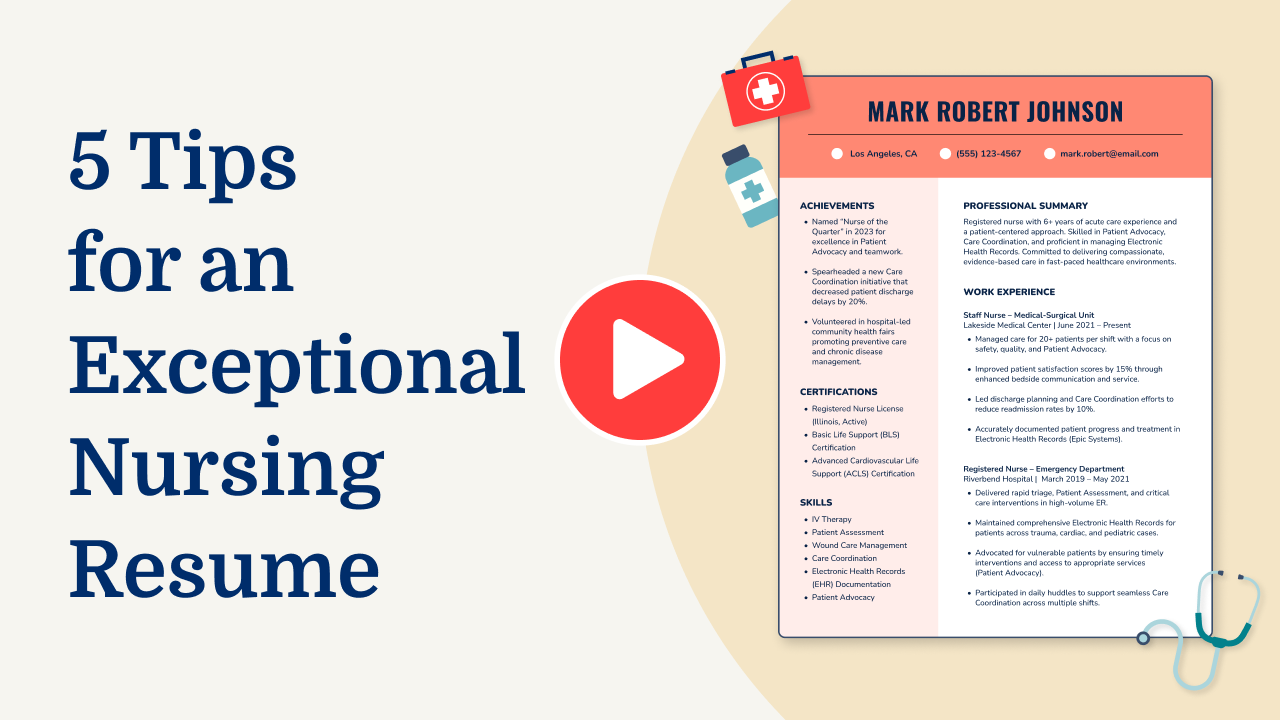
Write a strong professional summary
A professional summary is an introduction on a resume that provides hiring managers a snapshot of your experience and skills. When creating a resume, you can choose to include either a summary or an objective. Both serve as openings but cater to different stages of your career.
Typically made up of three to four sentences, a professional summary highlights your experience, key skills, and notable achievements. It’s best suited for experienced applicants who want to showcase their professional identity and the value they bring to roles like emergency room nurse. This section helps grab attention quickly by focusing on what you’ve accomplished.
Conversely, a resume objective centers on career goals and is ideal for entry-level applicants, those changing careers, or people with employment gaps. While summaries focus on “what I’ve accomplished,” objectives emphasize “what I aim to contribute.”
Next, we’ll explore examples of both summaries and objectives across various levels of experience to guide you in crafting your own compelling content.
Emergency room nurse resume summary examples
Entry-level
Recent nursing graduate with a Bachelor of Science in Nursing, eager to apply foundational knowledge and skills in an emergency room setting. Certified in Basic Life Support (BLS) and Advanced Cardiovascular Life Support (ACLS). Possesses strong clinical skills developed through rigorous coursework and hands-on training during clinical rotations. Committed to delivering compassionate patient care and learning from experienced healthcare professionals.
Mid-career
Emergency room nurse with over seven years of experience providing high-quality care in fast-paced hospital environments. Skilled in triage, managing critical patients, and collaborating with interdisciplinary teams to ensure effective treatment plans. Holds certifications in Trauma Nursing Core Course (TNCC) and Pediatric Advanced Life Support (PALS), recognized for quick decision-making abilities and a calm demeanor under pressure.
Experienced
Veteran emergency room nurse with 15+ years specializing in trauma care and crisis management. Proven leader known for mentoring new nurses, developing protocols for improved patient flow, and spearheading initiatives that improve departmental efficiency. Expert in advanced cardiac life support and trauma resuscitation techniques, committed to optimizing patient outcomes through strategic leadership and innovative approaches to emergency medicine.
Emergency room nurse resume objective examples
Recent graduate
Dedicated recent Bachelor of Science in Nursing graduate eager to begin a career as an emergency room nurse. Aspires to apply academic knowledge and clinical skills in a fast-paced ER environment, committed to delivering compassionate patient care and learning from experienced healthcare teams.
Career changer
Passionate healthcare professional transitioning into emergency room nursing with extensive experience in patient advocacy and acute care settings. Aims to leverage transferable skills and hands-on training to provide efficient and empathetic support in high-pressure ER situations.
Entry level with specialized training
Entry-level registered nurse with specialized certifications in trauma nursing and advanced cardiac life support seeking a position in an emergency department. Enthusiastic about using specialized training to assist the medical team in managing critical patient cases and improving outcomes.
Need help organizing your skills and experience? Use our Resume Builder to easily create a clear and professional resume that stands out.
Include relevant certifications and training
Certifications are important for an emergency room nurse because they show you have the skills needed to handle tough and fast-paced situations. They help prove that you know how to care for patients in emergencies and can make quick, smart decisions.
Having certifications can also set you apart from others applying for the same job. These credentials show you’re committed to learning and staying up to date with medical practices. Beneficial certifications for an ER nurse include:
- Advanced Cardiovascular Life Support (ACLS)
- Pediatric Advanced Life Support (PALS)
- Trauma Nursing Core Course (TNCC)
- Certified Emergency Nurse (CEN)
- Basic Life Support (BLS)
Listing these certifications in a special certifications section on your resume makes it easy for employers to see your qualifications at a glance. This can support your education details and give them confidence that you’re ready for the challenges of the ER.
Example of a certifications section
Certified Emergency Nurse (CEN)
Issued by: Board of Certification for Emergency Nursing (BCEN)
Advanced Cardiovascular Life Support (ACLS)
Issued by: American Heart Association
Pediatric Advanced Life Support (PALS)
Issued by: American Heart Association
Trauma Nursing Core Course Provider (TNCC)
Issued by: Emergency Nurses Association (ENA)
Basic Life Support (BLS) for Healthcare Providers
Issued by: American Heart Association
If you hold only one certification, add it alongside your degrees in the education section or alongside your RN license. Consider making a dedicated section for your certifications once you have a few to showcase.
Showcase your work experience
Including relevant work experience on your resume is important for showcasing your ability to handle the fast-paced and demanding environment of an emergency room nurse. This section allows you to highlight your hands-on expertise, demonstrating to potential employers that you can perform under pressure and deliver high-quality patient care.
List your experience in reverse-chronological order to help recruiters quickly see your most recent roles and responsibilities, providing a clear picture of how your skills have developed over time. When listing each position, start with your job title, followed by the employer’s name, location, and employment dates. Use action-oriented language to describe responsibilities and accomplishments. Focus on tasks like:
- Triaging patients
- Administering medications
- Monitoring vital signs
- Collaborating with healthcare teams during emergencies
Wherever possible, include measurable results—such as reducing wait times or improving patient outcomes—to show the impact of your work. For example, mention “assessed and prioritized care for 20+ patients per shift in a high-volume ER” or “trained new nurses on emergency protocols.”
Tailoring this section specifically to the emergency room setting will help demonstrate you’re prepared for its unique challenges while emphasizing both clinical skills and teamwork abilities.
5 emergency room nurse work history bullet point examples
- Triaged and prioritized emergency room cases, improving patient throughput by 25% during peak hours.
- Implemented a new documentation system that reduced record-keeping errors by 40%, improving patient care consistency.
- Collaborated with multidisciplinary teams to streamline treatment protocols, decreasing average patient wait time by 15 minutes.
- Educated over 200 patients and their families on post-discharge care plans, reducing hospital readmission rates by 10%.
- Led quality improvement initiatives that increased patient satisfaction scores in the emergency department by 18%.
Highlight your clinical expertise, certifications, and adaptability in healthcare settings by selecting a resume format tailored to showcase these critical skills effectively.
Match your resume with the job description
Tailoring your resume to the job description is essential. This practice helps you stand out to employers and ensures your resume passes through applicant tracking systems (ATS), which scan for specific keywords and phrases from job postings.
An ATS-friendly resume includes keywords that match the job description. By using terms that align with your skills, such as “patient care” or “clinical assessments,” you can increase your chances of getting noticed by hiring managers.
To identify relevant keywords from job postings, focus on skills, qualifications, and duties frequently mentioned. For an emergency room nurse role, look for terms like “healthcare team collaboration,” “patient assessment,” and “quick decision-making.”
Incorporate these terms naturally within your resume content. For example, if the job posting mentions providing high-quality patient care, you might write: “Delivered high-quality patient care to improve overall health outcomes.”
Targeted resumes improve ATS compatibility and increase the likelihood of being shortlisted by employers. By carefully customizing your resume with the job description, you not only meet system requirements but also effectively communicate your qualifications to potential employers.
Use our ATS Resume Checker to find over 30 common mistakes in your resume’s format and content. Get quick tips to boost your resume score right away.
FAQ
Do I need to include a cover letter with my emergency room nurse resume?
Including a well-written nursing cover letter with your resume can help you stand out from other applicants and secure more interviews.
A cover letter allows you to personalize your application by sharing your specific interest in the position and facility, elaborating on relevant experience, and showcasing your patient care skills.
If the hospital has a unique program, specialty, or unit (like oncology, NICU, or telemedicine initiatives), you can elaborate on your interest or experience in that area.
You can use our Cover Letter Generator to generate a cover letter based on your resume or create a brand-new one with step-by-step guidance and expert content suggestions.
We also recommend referencing our library of cover letter examples for additional samples tailored to various industries and career levels.
How long should a emergency room nurse resume be?
For an emergency room nurse, a one-page resume works well if you’re early in your career or have less experience. This format allows you to focus on key skills like patient care, quick decision-making, and any relevant certifications such as ACLS or PALS.
On the other hand, a two-page resume might be more appropriate if you’ve accumulated extensive experience or specialized training in emergency medicine. It gives room to detail your accomplishments, leadership roles, and advanced skills without overwhelming potential employers.
Ultimately, how long a resume should be depends on your unique experiences and achievements. Consider what’s most relevant to highlight for the role you’re targeting.
How do you write a emergency room nurse resume with no experience?
To create an emergency room nurse resume with no experience, emphasize your education, relevant skills, and any clinical training that has prepared you for the role. These elements are important in showcasing your readiness for the position.
- Showcase your nursing education: Begin with your nursing degree details, including the institution name, graduation date, and any honors or awards. Follow this with your RN license and certifications like ACLS or TNCC.
- Leverage clinical rotations: Treat clinical rotations as valuable experience by detailing specific tasks such as triage assessments, emergency procedures, and teamwork in high-pressure situations.
- Highlight transferable skills: Emphasize skills gained from related experiences like volunteer work or internships in healthcare environments. Focus on critical thinking, patient care abilities, and communication skills essential for an ER setting.
Check out our comprehensive guide on creating a resume with no experience to discover more examples and practical advice from Certified Professional Resume Writers.
Rate this article
Emergency Room Nurse
Additional Resources
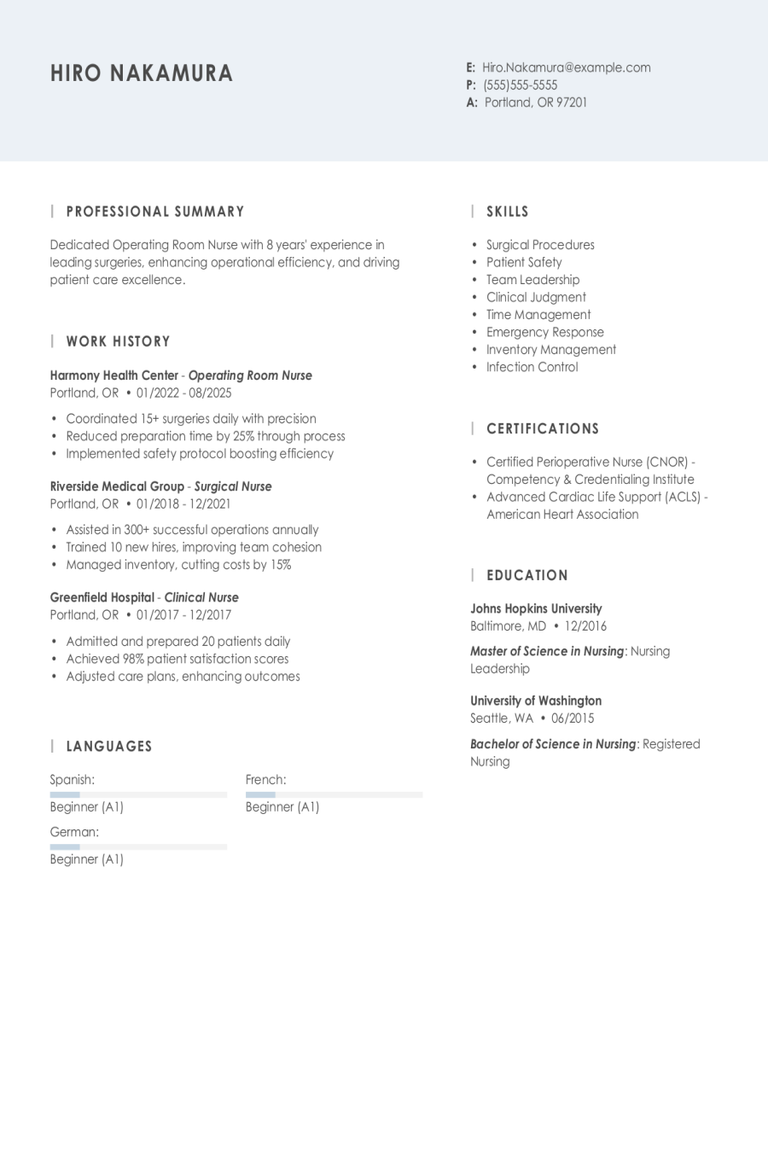
Operating Room Nurse Resume Examples & Templates for 2025
Discover how operating room nurses can showcase their teamwork and patient care skills. Use our examples and tips to help you write about your surgical support experience and attention to
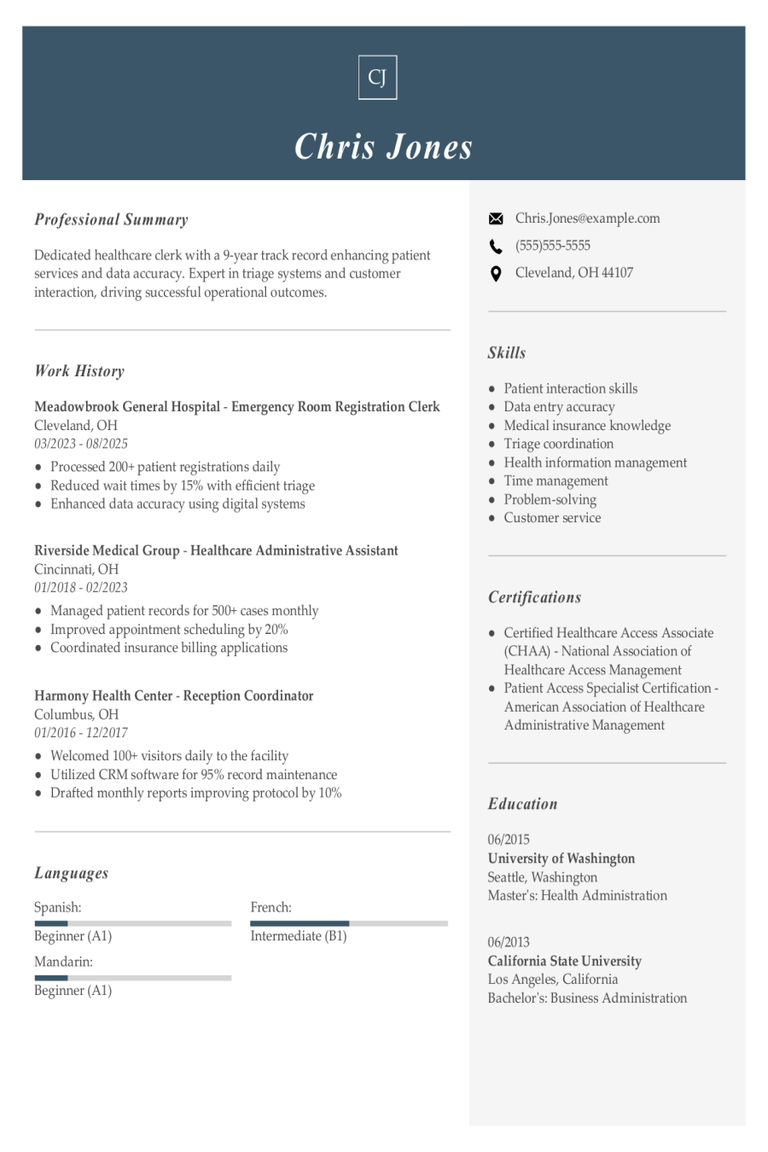
Emergency Room Registration Clerk Resume Examples & Templates for 2025
Explore emergency room registration clerk resume examples that focus on organizing patient information and managing front desk tasks. These samples and tips will help you showcase skills like customer service

Operating Room Registered Nurse & Templates
An operating room registered nurse is one of those professions that is easy to identify thanks to its constant portrayal in movies and television shows. But there is a great

Operating Room Registered Nurse & Templates
An operating room registered nurse is one of those professions that is easy to identify thanks to its constant portrayal in movies and television shows. But there is a great
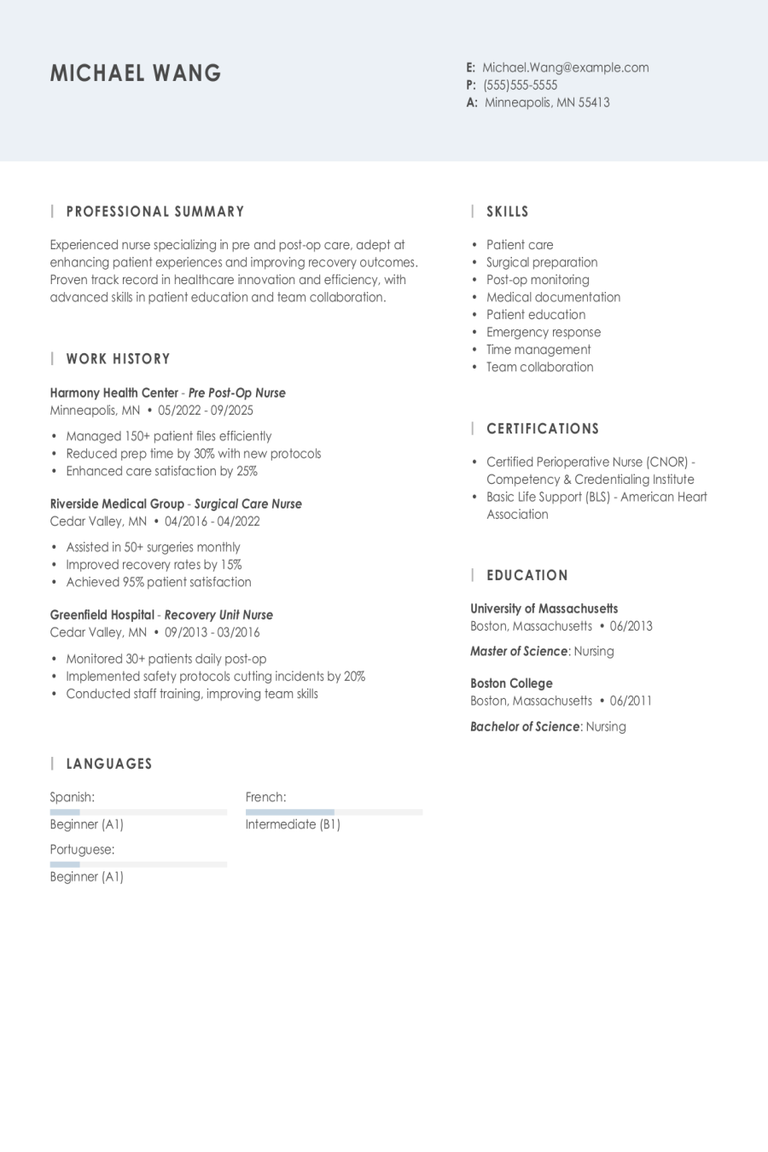
Pre Op/Post Op Nurse Resume Examples & Templates for 2025
These pre op/post op nurse resume examples show how to highlight your skills in patient care and surgical prep. Learn tips for showcasing your experience and making your qualifications stand
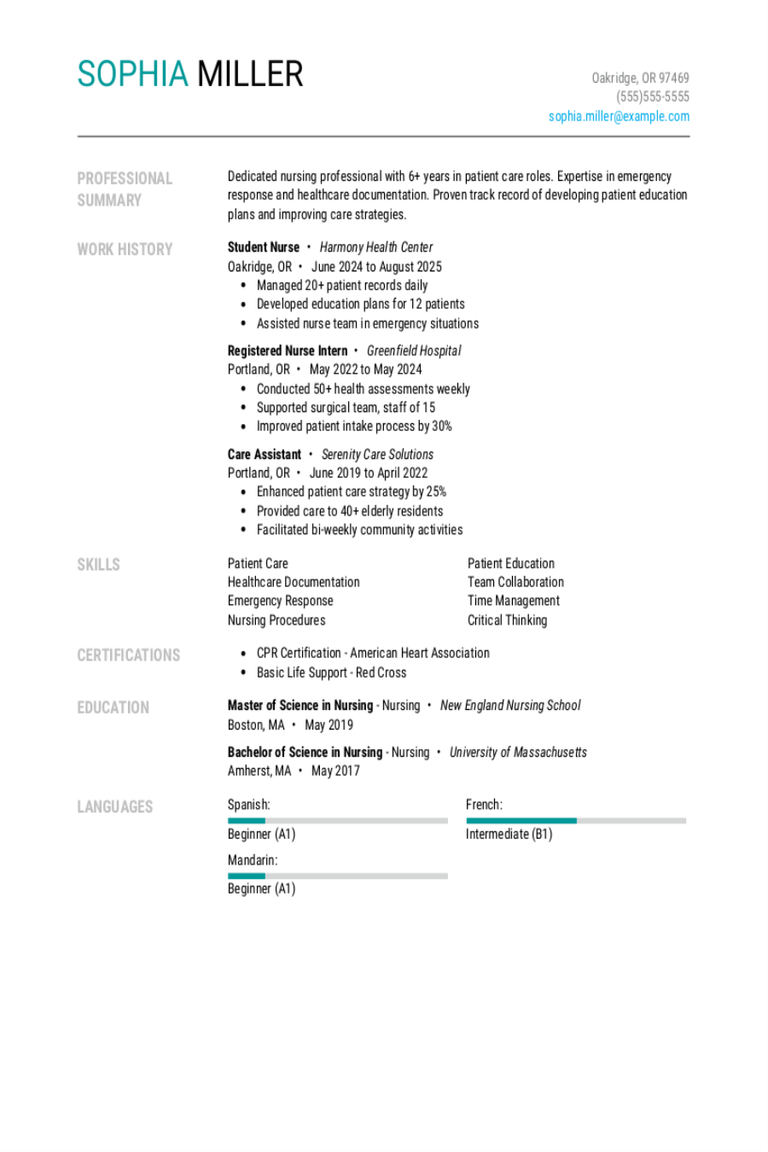
Student Nurse Resume Examples & Templates for 2025
Discover student nurse resume examples that show off patient care, teamwork, and time management. Learn how to present your skills and experiences to stand out in the healthcare field.Build my
